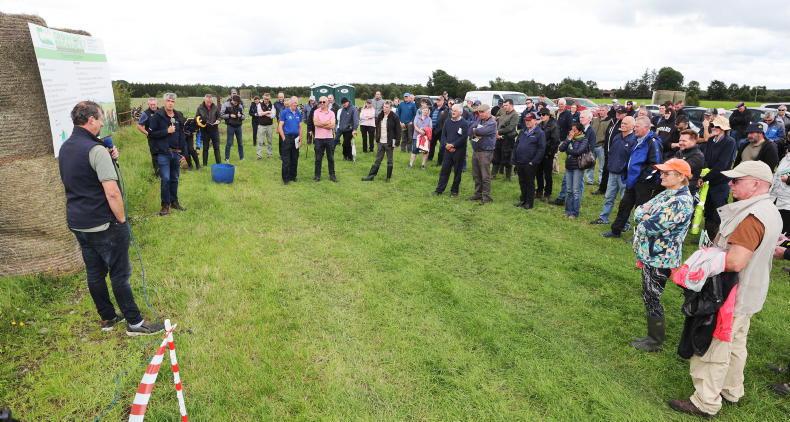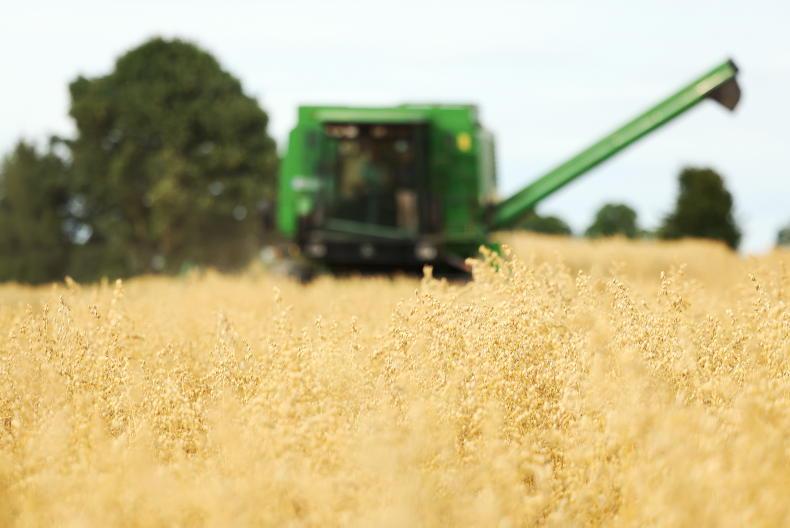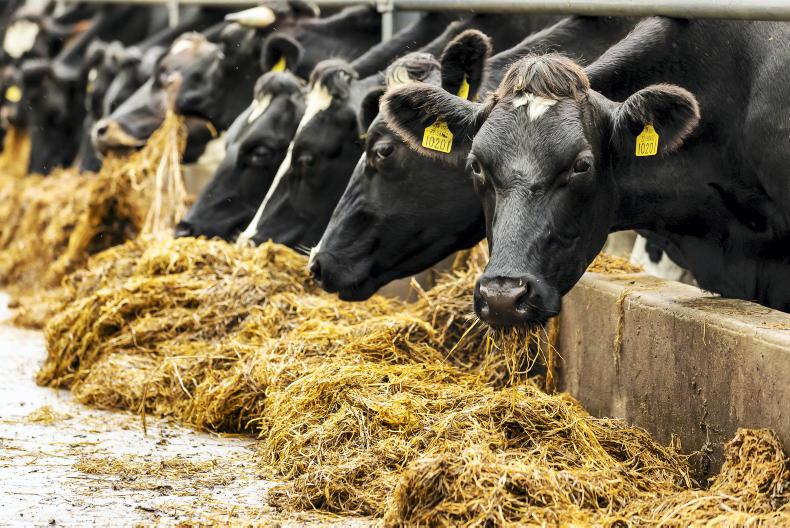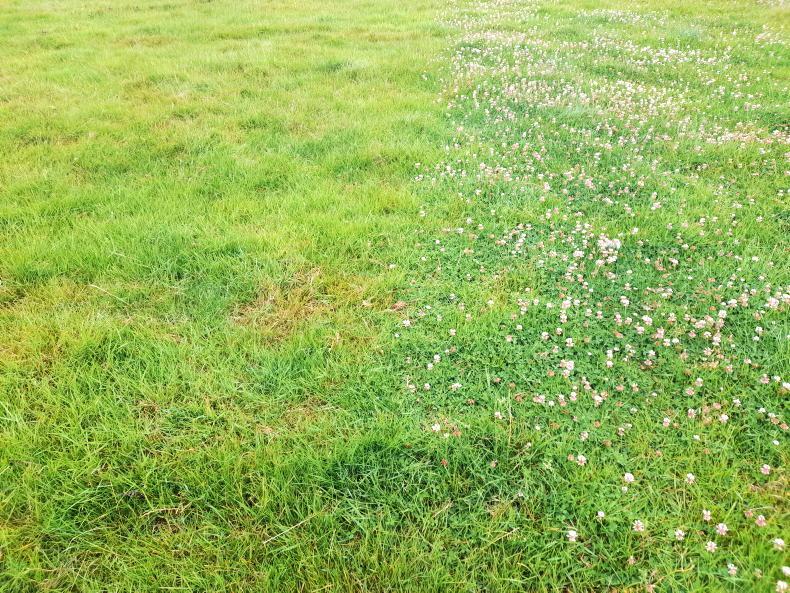With the growing number of people entering organic farming systems, the farm walk on Oliver and Ann Dixon’s farm, located outside Claremorris, Co Mayo, was always going to draw a crowd.
The walk was part of the “Growing Organics” series of walks organised by Teagasc and the Department of Agriculture to demonstrate and promote organic farming.
But with input costs of concentrates and fertiliser as high as they are, among the 250 or so farmers in attendance were a large number of conventional farmers who are looking at tweaking their own system and marry the benefits of conventional and organic farming together.
The Dixons were farming suckler cows before switching to organic, with Oliver targeting the export weanling market with high-end Limousin and Belgian Blue calves.
By his own admission, Oliver became “disillusioned” with conventional farming, which was resulting in heavy meal feeding and an overall large amount of input costs.
Conventional farming was also going against the Dixon family’s ethos, with both Oliver and Anna feeling that the organic route was much more in line with their beliefs. The farm began converting to organic in 2010 and achieved full organic status in May 2012.
The Dixon system
Oliver and Anna are suckler farming, bringing all their own stock (bar replacement heifers) through to finishing. Cow numbers are currently at 15 cows (Simmental x Angus) running with a Simmental bull, with an Angus bull retained for use on heifers.
The herd was hit with TB in recent years, with the plan being to increase cow numbers closer to the 20 mark.

Nicky Byrne, Teagasc Grange, explaining the benefits of red clover silage for both organic and conventional systems.
An additional 10 organic weanlings are purchased each autumn, with these brought through to finishing alongside the homebred stock.
The Dixons are farming a fragmented holding, similar to many suckler herds, with the home block comprising 26.54ha and the outblock being 17.15ha.
Land use is broken down to 4.85ha of red clover silage, 11.35ha of grass silage with 27.49ha of grazing ground.
Cows are calved from 1 April to allow them to calve outdoors or they can be quickly turned out post calving.
Oliver does this to reduce the risk of scours in his calves. Breeding takes place in July and August, with the Simmental bull running with the mature cows on the day, with the first calves from him at foot.
Soil health and fertility
One of the main barriers farmers see in converting to organic farming is the perceived downfall in soil fertility.
The Dixons contradict this theory, with close to two-thirds of the farm in Index 3 or 4 for both P and K, while close to half the farm is above 5.9 pH.

Cows calve down from April onwards and calved outdoors or turned on to grass soon after calving. Simmental x Angus cows, such as the one pictured, make up to majority of the herd.
Oliver plans to address the lower pH soils this year through spreading of lime, which is allowed in an organic system provided that there are soil sample results to solidify the need for lime.
Soil sampling is done every second year to monitor soil fertility.
Farmyard manure, of which there is a lot more in an organic system due to bedding requirements, and slurry, are used in a targeted manner. This is mainly on the grass silage and red clover swards. Cattle are rotationally grazed on the grazing block, with up to 90% of nutrients recycled back in to the sward from the dung and urine.
All slurry is spread using LESS technology.
Mark Plunkett, Teagasc, explained that the use of trailing shoes or dribble bars would increase N uptake by the sward by about 50%.
Ammonium-N, which is a readily available form of N that is easily lost to the atmosphere, makes up about 40% of the N concentration of slurry.
The timing of application (spring v summer) as well as the weather conditions (dull, overcast, light drizzle) all affected the amount of N loss to the atmosphere.
A key driver of profit on the farm is the red clover silage, according to Oliver.
Initially, the farm was purchasing in some organic concentrates to finish cattle, but Oliver found that this was too similar to the large outlay in concentrates that he was accustomed to in the conventional system that ate away farm profits.
Red clover silage was first sown in 2013, and has been a staple of the farming system ever since, acting as a direct replacement for bought-in concentrates for both finishing cattle and weanlings, with zero concentrates fed to either group.
Three to four cuts of silage per year are taken from the red clover swards, with the first cut taken in early May, with the final cut taken in September.
Slurry is returned back on to
paddocks after each cut, with the September cut sometimes left
unbaled and left to sit as green manure. Oliver does not graze the red clover sward at any stage as he is fearful of grazing the clover out of the sward. Nicky Byrne, Teagasc Grange, spoke on the day about how the research currently being conducted is seeing exactly why red clover silage is seeing increased weight gain from cattle.

Oliver and Anna Dixon with puppy, Leeroy.
“On our trial over the winter, our Angus x Friesian weanlings fed on red clover silage had a 20% higher weight gain than those fed grass silage, gaining 0.89kg on average, with 1.5kg barley fed head/day.’’
Weanlings on the red clover silage had a 28% higher dry matter intake in comparison to those on grass silage, with Byrne explaining that the rate of fibre digestion of red clover was much higher, moving at a greater pace through the rumen, resulting in a lower rumen fill and a higher intake rate.
Teagasc analysis, based on current fertiliser prices, indicates that a saving of €8/bale is seen through red clover silage, which at 25 to 26 bales/ha is seeing a saving of €200 /ha to €208/ha, excluding the increased animal performance.
Finishing performance and market
Twenty-one cattle were slaughtered in April and July of this year, aged between 23 and 28 months.
The 12 cattle in April had an average carcase weight of 337kg and an average carcase value of €2,010/head at €6/kg.
The July group had an average carcase weight of 341kg with a carcase value of €1,998/head at €5.90/kg. All cattle were slaughtered through Slaney Meats.
Local Teagasc organics adviser John Noonan highlighted there are issues with logistics around slaughtering animals under the organic scheme, due to the low number of factories doing organic slaughtering.
Close to 70% of the organic store lambs being presented in marts are moving on to conventional holdings. However, Bord Bia has stated that it is actively working on securing more market outlets for the increased organic produce that is envisaged to come on stream.
The financial performance of the farm can be seen in Table 2.
While the stocking rate for the farm is lower than for conventional cattle-rearing farms, it’s important to remember that the Dixons had a TB outbreak and are rebuilding numbers.
As they stand, they are selling surplus silage off the farm. As stock numbers increase, so to will gross output.
A key figure to note from Table 2 is that the net profit per hectare is €130 for the Dixons, while it is -€150 for conventional, meaning the farm is in a good position before direct payments are introduced. Oliver attributes this mainly to not having to purchase concentrates or fertiliser, two of the major costs in a conventional system.

Some of the red clover silage on the Dixon farm, with white clover and perennial ryegrasses sown alongside.
While billed as an organic farm walk, there was plenty of conventional farmers in attendance and no doubt they left with plenty to think about.
Red clover silage, with its nitrogen-fixing abilities and high feed value is definitely something that more conventional farmers will have to look towards as fertiliser and feed costs have constantly eroded finishing farm profits.
Looking at the Dixon finances, the elimination of these costs have them at €280/ha ahead of a conventional cattle farm, actually having a net profit before direct payments.
Too often, the focus on organic systems relates to the lucrative payments associated with it. But if we are looking towards imported organic soya at €1,200/t as a protein source, these payments will quickly disappear.
While organic farming will not be for everyone, there are certainly elements of it that can be adopted.
With the growing number of people entering organic farming systems, the farm walk on Oliver and Ann Dixon’s farm, located outside Claremorris, Co Mayo, was always going to draw a crowd.
The walk was part of the “Growing Organics” series of walks organised by Teagasc and the Department of Agriculture to demonstrate and promote organic farming.
But with input costs of concentrates and fertiliser as high as they are, among the 250 or so farmers in attendance were a large number of conventional farmers who are looking at tweaking their own system and marry the benefits of conventional and organic farming together.
The Dixons were farming suckler cows before switching to organic, with Oliver targeting the export weanling market with high-end Limousin and Belgian Blue calves.
By his own admission, Oliver became “disillusioned” with conventional farming, which was resulting in heavy meal feeding and an overall large amount of input costs.
Conventional farming was also going against the Dixon family’s ethos, with both Oliver and Anna feeling that the organic route was much more in line with their beliefs. The farm began converting to organic in 2010 and achieved full organic status in May 2012.
The Dixon system
Oliver and Anna are suckler farming, bringing all their own stock (bar replacement heifers) through to finishing. Cow numbers are currently at 15 cows (Simmental x Angus) running with a Simmental bull, with an Angus bull retained for use on heifers.
The herd was hit with TB in recent years, with the plan being to increase cow numbers closer to the 20 mark.

Nicky Byrne, Teagasc Grange, explaining the benefits of red clover silage for both organic and conventional systems.
An additional 10 organic weanlings are purchased each autumn, with these brought through to finishing alongside the homebred stock.
The Dixons are farming a fragmented holding, similar to many suckler herds, with the home block comprising 26.54ha and the outblock being 17.15ha.
Land use is broken down to 4.85ha of red clover silage, 11.35ha of grass silage with 27.49ha of grazing ground.
Cows are calved from 1 April to allow them to calve outdoors or they can be quickly turned out post calving.
Oliver does this to reduce the risk of scours in his calves. Breeding takes place in July and August, with the Simmental bull running with the mature cows on the day, with the first calves from him at foot.
Soil health and fertility
One of the main barriers farmers see in converting to organic farming is the perceived downfall in soil fertility.
The Dixons contradict this theory, with close to two-thirds of the farm in Index 3 or 4 for both P and K, while close to half the farm is above 5.9 pH.

Cows calve down from April onwards and calved outdoors or turned on to grass soon after calving. Simmental x Angus cows, such as the one pictured, make up to majority of the herd.
Oliver plans to address the lower pH soils this year through spreading of lime, which is allowed in an organic system provided that there are soil sample results to solidify the need for lime.
Soil sampling is done every second year to monitor soil fertility.
Farmyard manure, of which there is a lot more in an organic system due to bedding requirements, and slurry, are used in a targeted manner. This is mainly on the grass silage and red clover swards. Cattle are rotationally grazed on the grazing block, with up to 90% of nutrients recycled back in to the sward from the dung and urine.
All slurry is spread using LESS technology.
Mark Plunkett, Teagasc, explained that the use of trailing shoes or dribble bars would increase N uptake by the sward by about 50%.
Ammonium-N, which is a readily available form of N that is easily lost to the atmosphere, makes up about 40% of the N concentration of slurry.
The timing of application (spring v summer) as well as the weather conditions (dull, overcast, light drizzle) all affected the amount of N loss to the atmosphere.
A key driver of profit on the farm is the red clover silage, according to Oliver.
Initially, the farm was purchasing in some organic concentrates to finish cattle, but Oliver found that this was too similar to the large outlay in concentrates that he was accustomed to in the conventional system that ate away farm profits.
Red clover silage was first sown in 2013, and has been a staple of the farming system ever since, acting as a direct replacement for bought-in concentrates for both finishing cattle and weanlings, with zero concentrates fed to either group.
Three to four cuts of silage per year are taken from the red clover swards, with the first cut taken in early May, with the final cut taken in September.
Slurry is returned back on to
paddocks after each cut, with the September cut sometimes left
unbaled and left to sit as green manure. Oliver does not graze the red clover sward at any stage as he is fearful of grazing the clover out of the sward. Nicky Byrne, Teagasc Grange, spoke on the day about how the research currently being conducted is seeing exactly why red clover silage is seeing increased weight gain from cattle.

Oliver and Anna Dixon with puppy, Leeroy.
“On our trial over the winter, our Angus x Friesian weanlings fed on red clover silage had a 20% higher weight gain than those fed grass silage, gaining 0.89kg on average, with 1.5kg barley fed head/day.’’
Weanlings on the red clover silage had a 28% higher dry matter intake in comparison to those on grass silage, with Byrne explaining that the rate of fibre digestion of red clover was much higher, moving at a greater pace through the rumen, resulting in a lower rumen fill and a higher intake rate.
Teagasc analysis, based on current fertiliser prices, indicates that a saving of €8/bale is seen through red clover silage, which at 25 to 26 bales/ha is seeing a saving of €200 /ha to €208/ha, excluding the increased animal performance.
Finishing performance and market
Twenty-one cattle were slaughtered in April and July of this year, aged between 23 and 28 months.
The 12 cattle in April had an average carcase weight of 337kg and an average carcase value of €2,010/head at €6/kg.
The July group had an average carcase weight of 341kg with a carcase value of €1,998/head at €5.90/kg. All cattle were slaughtered through Slaney Meats.
Local Teagasc organics adviser John Noonan highlighted there are issues with logistics around slaughtering animals under the organic scheme, due to the low number of factories doing organic slaughtering.
Close to 70% of the organic store lambs being presented in marts are moving on to conventional holdings. However, Bord Bia has stated that it is actively working on securing more market outlets for the increased organic produce that is envisaged to come on stream.
The financial performance of the farm can be seen in Table 2.
While the stocking rate for the farm is lower than for conventional cattle-rearing farms, it’s important to remember that the Dixons had a TB outbreak and are rebuilding numbers.
As they stand, they are selling surplus silage off the farm. As stock numbers increase, so to will gross output.
A key figure to note from Table 2 is that the net profit per hectare is €130 for the Dixons, while it is -€150 for conventional, meaning the farm is in a good position before direct payments are introduced. Oliver attributes this mainly to not having to purchase concentrates or fertiliser, two of the major costs in a conventional system.

Some of the red clover silage on the Dixon farm, with white clover and perennial ryegrasses sown alongside.
While billed as an organic farm walk, there was plenty of conventional farmers in attendance and no doubt they left with plenty to think about.
Red clover silage, with its nitrogen-fixing abilities and high feed value is definitely something that more conventional farmers will have to look towards as fertiliser and feed costs have constantly eroded finishing farm profits.
Looking at the Dixon finances, the elimination of these costs have them at €280/ha ahead of a conventional cattle farm, actually having a net profit before direct payments.
Too often, the focus on organic systems relates to the lucrative payments associated with it. But if we are looking towards imported organic soya at €1,200/t as a protein source, these payments will quickly disappear.
While organic farming will not be for everyone, there are certainly elements of it that can be adopted.














SHARING OPTIONS